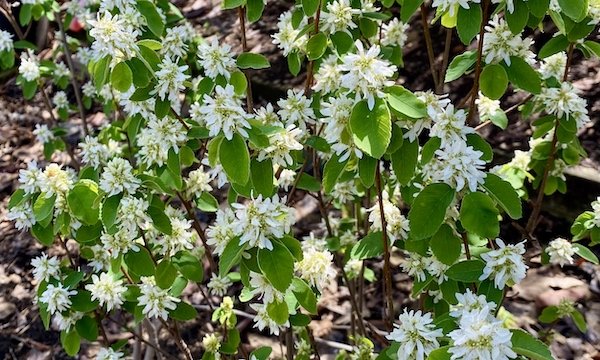This week: Early spring bloomers + big box native plants
Hello!
First, an announcement: This summer I am keeping a list of native plants that I find at my local Lowes and Home Depot big box stores. The first edition of the list is here and will be updated throughout the summer. I hope you can use this resource to inform your own plant shopping!
Now, back to the newsletter.
In the early spring native trees and shrubs do all the heavy lifting as food sources for pollinators, though a few perennials in the home landscape also lend a hand. This week, I thought I’d do a roundup of what’s in bloom in mid-to-late April here in Southwest Pennsylvania so you can get inspiration for your own spring flower show.

Flowering Dogwood (Cornus florida)
Our native tree-form dogwood is absolutely stunning either in white (pictured) or pink. While there are non-native dogwood trees in the landscape, you can always tell a native by its bloom time: early, and before the tree fully leafs out.

Eastern Redbud (Cercis canadensis)
Redbud, like Flowering Dogwood, is another understory tree that blooms before it leafs out. In the case of the redbud, flowers form directly on the branch. When in bloom, Redbuds are positively buzzing with bee activity. Later in the season, leaf cutter bees use cut segments of its foliage to build their nests. The cultivar pictured is ‘Heart of Gold,’ and you can see the yellow-hued leaves emerging.

Serviceberry (Amelanchier)
Lore has it that Serviceberry gets its common name because in olden times, it flowered at the same time that the ground thawed. This made it a sign that you could hold burial services for those who died over the cold, long winter. Serviceberries are small understory trees or shrubs, and are usually multi-stem. They are also called Juneberry because they produce berries in June. Mine (pictured) is a fastigiate shrub cultivar called ‘Ovation.’

Dwarf Fothergilla (Fothergilla gardenii)
Fothergilla’s bottle-brush spring flowers stand out because there’s simply not enough of these shrubs in the landscape. Fothergilla is a true three-season wonder. First, it blooms early. In the summer, its foliage is a soft-looking blueish green that contrasts against all the other greens in the garden. It’s perhaps most awesome in the late fall when the leaves turn blazing red and orange.

Virginia Bluebells (Mertensia virginica)
I have world’s smallest patch of bluebells in my garden and I eagerly anticipate their blooms every spring. Usually bluebells will seed themselves into gorgeous drifts, but seemingly not at my house. Anyway! These spring ephemerals only flower for a few weeks before vanishing in the summer heat.

Creeping Phlox (Phlox subulata)
Low-growing and colorful (usually in pinks, whites, purples, and blues) you can spot a cultivar of this ubiquitous native perennial in practically every neighborhood. This weekend there were no fewer than 8 different varieties at my local Home Depot, so it’s an easy plant to source.
Elsewhere:
The Joe Gardener podcast featured Mt. Cuba Center’s latest research on Carex (also called sedge). Listen to hear how they conduct their plant trials and learn which grass-like sedges came out on top for use in the home landscape.
Have a great week,
Julie